The number of mobile operators that will launch 5G networks will reach 50 in 2020 from 25 in 2019, Deloitte predictions for Technology, Media & Telecommunications for 2019 said today.
 72 operators are currently testing 5G network. Over 1 million 5G handsets are expected to be sold in 2019, and that number should expand to 15 to 20 million units by 2020. A further one million 5G modems/pucks are also predicted to sell in 2019, the report on 5G networks said.
72 operators are currently testing 5G network. Over 1 million 5G handsets are expected to be sold in 2019, and that number should expand to 15 to 20 million units by 2020. A further one million 5G modems/pucks are also predicted to sell in 2019, the report on 5G networks said.
The recent Strategy Analytics predictions say commercial 5G networks will be in place in 15 markets at some level in 2019 but subscribers will be under 6 million. 5G smartphones will be niche and expensive unless subsidies return. Silicon technology will capture market share in 5G millimeter wave front end functions.
5G devices
“5G will change our interactions and experiences, which is good news for consumers as they demand better performance and more access to content,” said Kevin Westcott, vice chairman and U.S. telecommunications, media and entertainment sector leader, Deloitte.
20 handset vendors will launch 5G-ready handsets in 2019 with the first available in Q2, and they will ship about 1 million 5G handsets out of a projected 1.5 billion smartphone handsets sold in 2019.
One million 5G modems also known as pucks or hotspots will be sold, and around a million 5G fixed wireless access devices will be installed.
5G handset sales will reach 15–20 million units representing approximately 1 percent of all smartphone sales at the end of 2020. 5G handset sale will reach more than 100 million 5G handsets in 2021.
Main applications
Mobile connectivity for retail consumers, connectivity to less mobile devices, mainly 5G modems or hotspots, and 5G fixed-wireless access (FWA) devices, with antennas permanently mounted on buildings or in windows, providing a home or business with broadband in place of a wired connection, will be the main applications of 5G.
Cost of devices
A bundled 4G chip for a high-end phone cost an estimated $70 in 2018; the 5G version will almost certainly cost more.
The antennas and front end of a 4G smartphone typically cost around $20 in 2018, and 5G solutions, expected to be available in 2019, will almost certainly carry a higher price—possibly much higher.
5G-ready phone’s component costs in 2019 will be $40–50 higher than for a comparable 4G phone — for a phone with relatively few networks worldwide to connect to, and likely with only narrow coverage even where available.
Chipmakers have said that they expect battery life for the first 5G phones to be more or less in line with that of current 4G handsets.
Capex guidance
As 2018’s field trials progressed, many operators in North America, Europe, and Japan are re-evaluating the cost, and releasing public guidance that Capex intensity for 5G will be more or less flat with their 4G spending.
One major reason for this is that they have pre-loaded spending by investing in denser fiber networks in anticipation of 5G in the future, as well as by purchasing 5G-ready radio hardware that can be upgraded to full 5G with software upgrades when the time for launch comes.
5G spectrum price
Based on some early auctions, the prices for 5G spectrum, depending on the frequency band, are consistent with those for 4G spectrum: All auctions in the six countries have been for less than $0.20 MHz pop, and two were under a penny.
Italian spectrum auction in October 2018 saw higher prices, with 700 MHz spectrum commanding $0.65 MHz pop, and the mid-band 3.6–3.8 GHz frequencies priced at more than $0.42 MHz pop.





